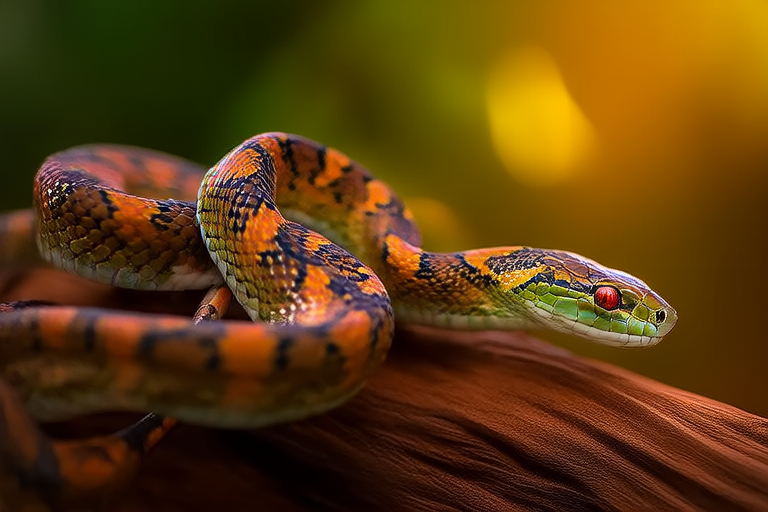From Jungle to Home: How to Care for Your Rainbow Boa
The rainbow boa (Epicrates cenchria) is a captivating reptile known for its iridescent scales and gentle demeanor. Originating from the lush rainforests of South America, these snakes have become popular pets among enthusiasts due to their striking appearance and manageable size. This comprehensive guide will walk you through everything you need to know about caring for your rainbow boa, from understanding its natural habitat to providing optimal care at home.
Natural Habitat and Behavior
Rainbow boas inhabit various regions within South America, including Brazil, Colombia, Ecuador, Peru, Venezuela, Guyana, Suriname, French Guiana, Bolivia, and Trinidad. They thrive in tropical rainforests characterized by high humidity levels and warm temperatures. These environments provide ideal conditions for these semi-aquatic snakes, which spend much of their time near water bodies like streams or rivers.
Behaviorally, rainbow boas are generally docile creatures that enjoy burrowing into substrate or hiding under objects within their enclosure. They are nocturnal animals, meaning they are most active during the night. In captivity, rainbow boas tend to be calm and easy to handle once acclimated, making them suitable for both novice and experienced snake owners alike.
Ideal Tank Setup
Creating an appropriate living space for your rainbow boa is crucial to ensure its well-being. The tank size should reflect the adult size of the snake; a minimum enclosure of 48 inches long x 24 inches wide x 24 inches high (122 cm x 61 cm x 61 cm) is recommended for adults. Juveniles can start in smaller enclosures but will require larger spaces as they grow.
Temperature regulation plays a significant role in maintaining a healthy environment. Maintain daytime temperatures between 82°F and 86°F (28°C – 30°C) with a basking spot reaching up to 90°F (32°C). Nighttime temperatures can drop slightly to around 75°F (24°C). Use thermometers placed at both ends of the enclosure to monitor these values accurately.
Humidity levels must also be carefully controlled, ideally ranging between 60% and 80%. Achieve this by misting the enclosure daily and ensuring there’s always fresh water available. Substrate options include coconut fiber, bark chips, or eco-earth, all of which help maintain proper moisture levels while being safe for the snake.
Lighting is essential for simulating day-night cycles, promoting healthy digestion, and enhancing mood. Full-spectrum UVB lights are beneficial but not strictly necessary unless the snake spends considerable time outside its enclosure. Always consult reputable sources when setting up your rainbow boa’s habitat to avoid potential pitfalls.
Proper Diet and Feeding Schedule
Rainbow boas primarily feed on small mammals such as mice and rats. Younger snakes typically consume pinkies or fuzzies, progressing to larger prey items as they mature. Adults may eat every 1-2 weeks depending on their size and metabolism.
It’s important to offer pre-killed or humanely euthanized prey to prevent injury to your snake. Thaw frozen rodents thoroughly before offering them to your pet. Avoid overfeeding, as obesity can lead to health problems. Monitor your boa’s weight regularly and adjust feeding frequency accordingly.
Handling and Socialization Tips
Regular handling helps build trust between you and your rainbow boa. Start sessions gently and gradually increase duration over time. Always support the snake’s body properly, especially around the midsection. Avoid sudden movements or loud noises that might startle it.
Patience is key when introducing new stimuli into the enclosure. Introduce novel objects slowly and allow the snake ample time to explore them without pressure. Over time, your rainbow boa will become more comfortable with its surroundings and handlers.
Common Health Issues and Preventive Care
Like any animal, rainbow boas are susceptible to certain health issues. Respiratory infections, mites, and skin disorders are common concerns. Regular veterinary checkups can help catch problems early. Maintaining clean living conditions and monitoring diet contribute significantly to overall health.
Vaccinations aren’t typically required for rainbow boas, but routine examinations by a qualified herpetologist are advisable. Keep records of all treatments administered and any changes in behavior noted. Early intervention often leads to better outcomes.
Breeding Considerations
If breeding rainbow boas is part of your plan, consider factors such as age, sex ratio, and genetic diversity. Females usually reach sexual maturity around two years old, while males mature slightly earlier. Provide separate housing during breeding season to minimize stress.
Courtship involves elaborate displays where males attempt to entice females. Successful mating results in egg-laying approximately two months later. Incubation lasts about 60 days under controlled conditions. Hatchlings emerge fully developed and ready to fend for themselves.
Tips for Beginners vs Experienced Owners
For beginners, focus on mastering basic husbandry techniques before attempting advanced practices like breeding. Join online forums or local clubs dedicated to exotic pets for support and advice. Experienced owners might explore specialized diets or environmental enrichment projects.
No matter your level of expertise, continuous learning is vital. Stay informed about advancements in care methods and stay connected with fellow enthusiasts who share similar interests.
